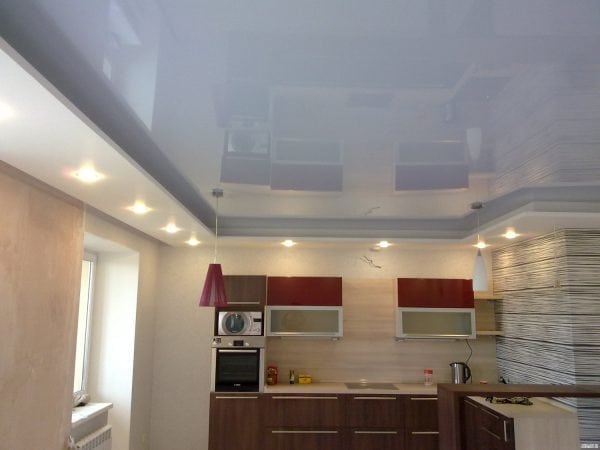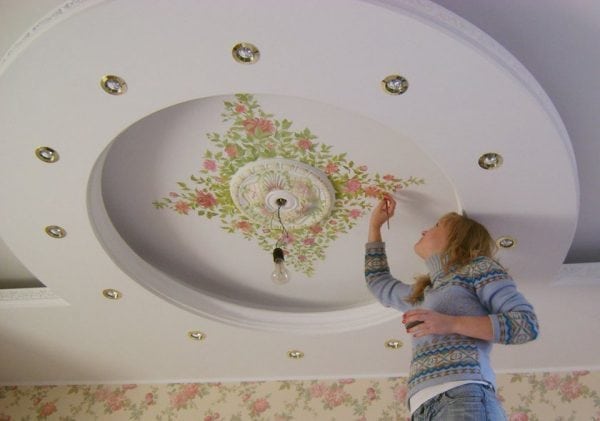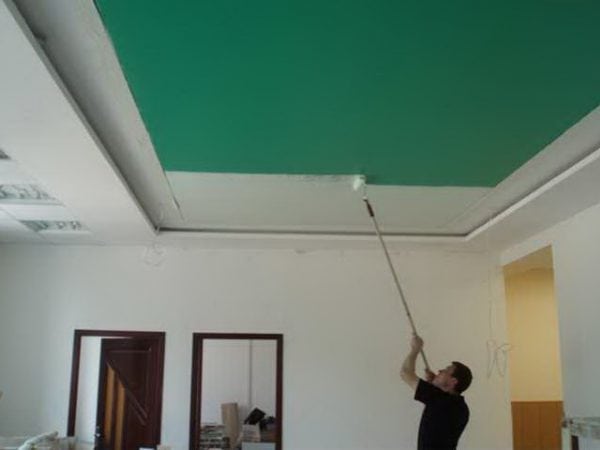Stretch ceilings in recent years have become a popular solution for repairs. This is due to the practicality, ease of installation and external attractiveness of the coating.
- Varieties of stretch ceilings
- Is painting a stretch ceiling acceptable
- PVC and painting
- Painting fabric ceilings
- Painting technology
- Materials and Tools
- Preparatory work
- Painting
- Care Tips

Trying to choose an individual interior for a room, many think about whether painting a stretch ceiling is acceptable. Technically, this is real, but you need to know the nuances. In particular, fabric ceilings lend themselves well to coloring, but film coatings will become worthless.
to contents ↑Varieties of stretch ceilings
Stretch coatings for ceilings are usually divided into 2 types:
- polyvinyl chloride (abbreviated as PVC);
- fabric.
Between these types of coatings there are both purely quantitative and fundamental differences. For example, the specific gravity of a PVC film material can range from 180 to 320 grams per square meter, and the ceiling thickness is 0.15 to 0.35 millimeters. A square meter of fabric ceiling weighs an average of 200 grams and has a thickness of 0.25 millimeters.
A more significant difference in the structure of materials. Like film, fabric coatings are made from polymers. The name "fabric" is conditional, since polyvinyl chloride is used as the basis for such coatings. However, in fabric materials, PVC is used not as a film, but as an impregnation.
The film stretches when heated and when it reaches a certain temperature (65 degrees) it becomes like rubber. Unlike the film, the fabric freely passes oxygen. This allows you to maintain a favorable microclimate in the room.
According to their texture, coatings are divided into 3 types:
- Matt They are characterized by maximum density and strength. Able to maintain color characteristics, regardless of the type of lighting in the room. Most often, matte surfaces are white and are used when you need to simulate a whitewashed or plastered ceiling. Matte coatings are the most affordable.
- Glossy. Coatings of this type are decorative and of sufficient strength. Glossy ceilings do not fade from sunlight. The lack of gloss is that even the smallest defects are striking.
- Satin They are considered an intermediate option between glossy and matte coatings. Satin ceilings are so called because of the special structure of the canvas, outwardly resembling fabric. Satin coatings are in many ways similar to matte, but satin is characterized by higher strength, repels dust and does not condense moisture.
Is painting a stretch ceiling acceptable
Is it worth painting a stretch coating? It all depends on the type of stretch ceiling.
PVC and painting
Polyvinyl chloride films are strong and flexible. As a result of heating, the film is stretched by about 20 - 25%. After cooling, the film straightens, and its strength is maintained.
However, the strength characteristics cannot be called comprehensive: the material does not tear under the weight of water, but is easily pierced by a more or less sharp object. This property is due to the absence of any reinforcing elements.
Painting a polyvinyl chloride film will not give a positive result.If you paint PVC with water-dispersion paint, you will not be able to provide reliable adhesion (adhesion of materials), which will lead to shedding of the paint layer.
Using synthetic paint will make the coating heavier. Since PVC ceilings are not reinforced, the material will sag. The ceiling cannot be returned to its original position due to the drying of the paint layer. In addition, synthetic paints corrode the film, forming gaps in the coating.
PVC ceilings are recommended not to be painted, but treated by airbrushing. The prices for such services are high and may exceed the cost of the ceilings themselves.
to contents ↑Painting fabric ceilings
The basis of the fabric stretch ceiling is polyester, impregnated on both sides with polymer. The polymer component is the reinforcing element. The elasticity of the material is lost. In this case, this is an advantage, since even a surface painted in several layers does not sag.
For technological reasons, the fabric coating is not glossy, but always matte. Such a surface is more difficult to clean from dirt. However, there is a more important advantage - excellent adhesion with paints and varnishes.
to contents ↑Painting technology
The workflow consists of preparatory work and direct application of paint to the stretch ceiling. It is necessary to choose the right tools and materials for the job.
Materials and Tools
Water-based formulations are used to paint fabric ceilings. The best option is latex paint. It gives the viscosity of the coating (which is important for stretched fabric), it adheres well to the surface. If there is no latex paint, a high-quality water-based composition is suitable. Most often, white paints are acquired for painting, which, if necessary, are tinted.
Organic-based or nitrocellulose-containing formulations are not suitable for painting ceilings. The problem here is not the overlapping of pores in the base material, since any stretch ceiling is an airtight shell. Organics are not suitable for another reason: it violates the structure of the tissue, weakening the stiffness of the material.
It is better to use a spray gun rather than a roller as a working tool: this way the surface is treated more delicately, and the paint is distributed as evenly as possible. The market presents a wide variety of models of spray guns. It is not necessary to buy expensive pneumatic spray guns, manual modification will also work.
to contents ↑Preparatory work
First you need to clean the surface of dust, oil stains and any other contaminants. This should be done with delicate detergents. The sponge should be soft, made of foam rubber (flannel fabric is also suitable).
In order not to stain anything during work, the room should be freed from furniture and household appliances. Foreign surfaces are recommended to cover with plastic wrap or sheets of thick paper.
Drafts should be avoided in the room, so the doors to the room should be closed until the paint is completely dry. Direct sunlight is not allowed on a freshly painted surface (windows must be curtained).
If the room has high ceilings, you will need flooring. Paint is distributed along the entire length of the room without jet breaks. Otherwise, uniformity of coverage cannot be achieved.
to contents ↑Painting
The paint is prepared according to the instructions of the manufacturer. Then the composition is filled with a spray gun and proceed to painting.
Note! Painting work is carried out in special clothing and using personal protective equipment (glasses, a respirator).
Normal coating thickness is achieved by two layers of paint material. This allows you to hide the old background, provides uniform coverage and color depth. A greater number of layers is allowed: their specific number is determined by the opacity of the paint, the thickness of each layer, the specific gravity of the paintwork composition, the type of material to be painted.
Advice! Testing is recommended. This will allow you to determine the necessary pressure and the width of the stream.
The first layer of paint is directed perpendicular to the rays of light, and the second in parallel. The final movement of the spray gun is sent around the world (that is, from the window).
The paint is applied in stripes so as to overlap the previous layer by 10 - 15 centimeters. Each strip should be applied at a time, without turning off the spray gun. The next layer is applied after the previous one dries. Recommended dates are indicated in the manufacturer's instructions.
to contents ↑Care Tips
Some helpful suggestions for painting and maintaining a painted stretch ceiling:
- Repainting is allowed no more than 5-6 times, since the canvas is gradually stretched under the weight of the paint material, becoming unusable. If the canvas area is large, then the maximum number of stains is 3.
- When caring for the coating, discard brushes with hard bristles. Do not wash the stretch ceiling with any sharp devices.
- Solvents, alkalis, and detergents containing ammonia are not suitable for the maintenance of painted ceilings.
- For cleaning stretch ceilings produced special detergents. Well proven sprays for cleaning mirrors.
- If there are no specialized chemicals, ordinary laundry soap diluted in warm water is suitable. The soap composition is applied to the coating with translational, but not circular motions. This avoids stains on the surface.
- In order for the glossy surface to shine, it must be treated with a solution of ammonia (water and ammonia).
- It is not necessary to carry out wet cleaning too often so as not to damage the paint layer. One procedure is enough in a 6-month period.
Fabric coatings are much more expensive than film. Usually we are talking about one and a half to two times the difference in price. There is nothing unusual about painting fabric material - this is the standard procedure for this type of ceiling. Even a novice master will be able to cope with the work if he shows zeal and follows the instructions.












